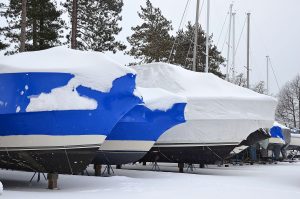 When decommissioning a boat for the winter, preparing the marine battery properly for storage will ensure that the engine will start when the boat is re-commissioned in the spring. Following the appropriate maintenance and storage practices are necessary for the battery to perform reliably throughout its intended service life.
When decommissioning a boat for the winter, preparing the marine battery properly for storage will ensure that the engine will start when the boat is re-commissioned in the spring. Following the appropriate maintenance and storage practices are necessary for the battery to perform reliably throughout its intended service life.
Battery Technologies
Some battery technologies are better suited for long-term storage than others.
Absorbed Glass Mat (AGM) batteries are among the better choices of batteries since they are virtually maintenance-free. Unlike conventional flooded lead acid batteries that have plates immersed in a sulfuric acid electrolyte, AGM batteries contain fiberglass separators between each plate to absorb the electrolyte. This makes the battery leakproof with no additional water or electrolyte ever required.
Thin Plate Pure Lead (TPPL) Technology
In addition to virtually maintenance-free service, AGM batteries that feature advanced Thin Plate Pure Lead (TPPL) technology offer even more advantages. AGM TPPL batteries, like the ODYSSEY® battery from EnerSys®, feature pure lead plates that do not corrode as flooded and other AGM batteries can do. The TPPL plates can be made thinner than lead alloy plates to create greater surface area that provides more power and higher cranking capability. ODYSSEY® batteries with TPPL technology have a low self-discharge rate, which is good for storage as well as a low internal resistance, which allows them to start even in cold temperatures.
Proper Charging
When the battery will be dormant for more than a few weeks, as is typical during winter, it should be fully charged before being placed in storage. Proper charging of the battery is the single most important action in ensuring that the battery will perform as intended and have a long service life. Different battery types (chemistries) require different charging profiles, so be sure to consult the manufacturer’s recommendations or contact your local battery specialist before charging it. If you are unsure if the battery is fully charged, you can measure the voltage of the battery, which indicates its State of Charge (SOC), using a digital voltmeter. The battery manufacturer’s specifications will indicate what OCV will correspond to 100% SOC.
Once the battery is fully charged, the best practice is to disconnect the negative battery cable to prevent excessive discharge from any parasitic loads on the boat. If this is not possible, then consider using a trickle charger.
Managing Parasitic Loads with Trickle Charging
Onboard electronics, such as communications and instrumentation systems, can create parasitic loads that will drain the battery if the boat’s engine remains inactive long enough. Consider a boat that has a parasitic draw of 20 milliamps and is stored for 5 months with the battery connected to the load. In that 150-day period, that parasitic draw will consume more than 70AH. Care should be taken to ensure that the battery isn’t discharged to less than 50% SOC to prevent internal damage and enable the engine to start when needed.
Connection to a trickle charger will prevent excessive discharge of the battery from these parasitic loads. When using a trickle charger, it is important to know whether or not it will adequately charge the battery type it is being used with. For example, trickle chargers are not suitable for recharging an ODYSSEY® TPPL battery that has been deeply discharged. However, they are suitable for maintaining TPPL batteries at a full SOC, provided that the float voltage setting is appropriate. For TPPL batteries, the recommended float voltage is 13.6V for a 12V battery.
Proper Temperatures for Storage
In addition to charging the battery, ensure that the battery is stored at an appropriate temperature. The electrolyte in an acid-filled battery may freeze if the battery is stored in an unheated environment during the winter. This happens if the battery gets discharged, as the lower the SOC, the closer the internal electrolyte gets to water, which freezes at 32°F(0°C).
Colder temperatures slow the self-discharge rate of batteries, but if parasitic loads are present, the discharge rate will accelerate. Therefore, if the boat has to be stored outside in cold climates, periodic charging (if not connected to a trickle charger or battery maintainer) should be conducted to ensure batteries are kept at a full SOC.
Return to Service
It is always best practice to fully recharge batteries before placing them back in service to help ensure best performance.
Conclusion
Proper preparation of the battery for storage during the winter will ensure its operation when the boat is recommissioned in the spring. Choosing the best battery technology, suited for both the application and storage needs and environment, makes the winterization process easier. Always be sure to follow the manufacturer’s guidelines for battery care and handling, and direct any questions to your battery professional.
ABOUT ENERSYS®
EnerSys, the global leader in stored energy solutions for industrial applications, manufactures and distributes energy systems solutions and motive power batteries, specialty batteries, battery chargers, power equipment, battery accessories and outdoor equipment enclosure solutions to customers worldwide. Energy Systems, which combine enclosures, power conversion, power distribution and energy storage, are used in the telecommunication, broadband and utility industries, uninterruptible power supplies and numerous applications. Motive power batteries and chargers are utilized in electric forklift trucks and other industrial electric powered vehicles requiring stored energy solutions. Specialty batteries are used in aerospace and defense applications, large over-the-road trucks, premium automotive, medical and security systems applications. EnerSys also provides aftermarket and customer support services to its customers in over 100 countries through its sales and manufacturing locations around the world. With the recent NorthStar acquisition, EnerSys has solidified its position as the market leader for premium Thin Plate Pure Lead batteries, which are sold across all three lines of business. More information regarding EnerSys can be found at www.enersys.com.


